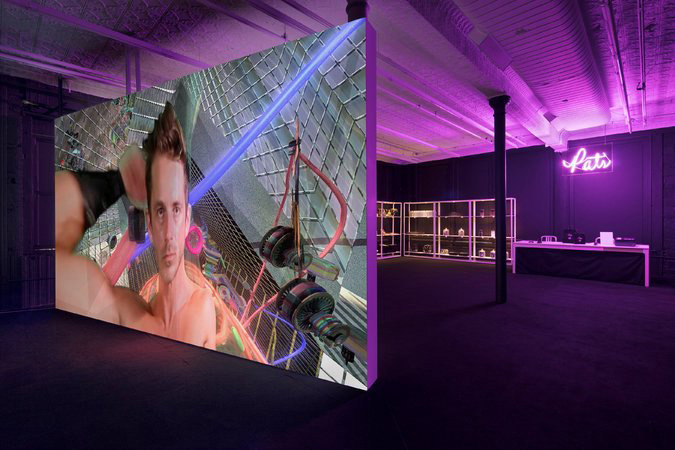
- Source: The New York Times
- Author: Martha Schwendener
- Date: April 11, 2018
- Format: PRINT AND DIGITAL
Jacolby Satterwhite: BLESSED AVENUE
Exhibition Review

Jacolby Satterwhite’s Blessed Avenue, 2018. Credit Lance Brewer/Gavin Brown’s enterprise
There is a lot to see, hear and buy in Jacolby Satterwhite’s “Blessed Avenue” at Gavin Brown on the Lower East Side. A pop-up store in the gallery is selling cheap bespoke items like pencils, pill cases and bottled water. An eerie, disembodied voice, singing in an R&B-inflected falsetto, filters throughout the space and you can purchase Mr. Satterwhite’s new self-described concept album, also titled “Blessed Avenue.”
The centerpiece of the show, however, is a 20-minute psychedelic video created in the animation software Maya. The images here are in constant motion, like a giant kaleidoscope with twisting and turning architectural spaces, nude figures posing and intertwined with one another (actual sex is more veiled than obvious) and motifs like a long twisting braid (perhaps a tail, snake or whip). It’s a virtual gay sex club or a free-love spaceship drifting through some unknown universe. Mr. Satterwhite appears in nonanimated form, via green-screen technology, dressed to kill (at the club or on the catwalk), performing a combination of kung fu and vogueing poses in an unidentified Chinese shopping district.
The whole presentation is sensorially rich but risks being vapid — high on effect and low on pretty much everything else — until you learn that the voice accompanying the video belongs to the artist’s mother, Patricia Satterwhite, who was schizophrenic and died in 2016. Ms. Satterwhite also made the pencil drawings on display in the office (culled from nearly 10,000 of her drawings, many inspired by watching home-shopping television shows) and which helped influence the products in the shop. Suddenly, the show gains gravity, becoming a collaboration, a memorial and immersive queer nightclub. It’s a complicated union, but perhaps a visionary antidote, both to grief and to the dystopian gloom that artists working in the cyber-futuristic mode often feel obliged to embrace.

